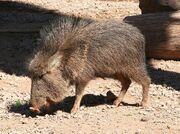| Tayassuidae | |
|---|---|
 Collared Peccary (Pecari tajacu) | |
| Scientific Classification | |
| Kingdom | Animalia |
| Phylum | Chordata |
| Class | Mammalia |
| Order | Artiodactyla Suina |
| Family | Tayassuidae |
Tayassuidae or peccaries, is a family of medium-sized hoofed mammal in the suborder Suina along with the Suidae (Old World pigs). They are found in the southwestern area of North America and throughout Central and South America. Peccaries usually measure between 90 and 130 centimetres (3.0 and 4.3 ft) in length, and a full-grown adult usually weighs between about 20 to 40 kg (44 to 88 lb).
Peccaries, which are native to the Americas, are often confused with the Suidae family that originated in Afro-Eurasia, especially since some domestic pigs brought by European settlers have escaped over the years and now run wild as "razorback" hogs in many parts of the United States.
In many countries, especially in the developing world, they are raised on farms as a source of food for local communities.
Appearance[]
A peccary is a medium-sized animal, with a strong resemblance to pigs. Like pigs, it has a snout ending in a cartilagenous disc, and eyes that are small relative to its head. Also like pigs, it uses only the middle two digits for walking, although, unlike pigs, the other toes may be altogether absent. Its stomach is nonruminating, although it has three chambers, and is more complex than that of pigs.
Evolution[]
Peccaries first appeared in the fossil records of the Late Eocene or Early Oligocene periods in Europe. Fossils have later been found in all continents except Australia and Antarctica. It became extinct in the Old World sometime after the Miocene period. Macrogenis was one example of a Miocene peccary. Although they are common in South America today, peccaries did not reach that continent until about three million years ago during the Great American Interchange, when the Isthmus of Panama formed, connecting North America and South America. At that time, many North American animals—including peccaries, llamas and tapirs—entered South America, while some South American species, such as the ground sloths, and opossums, migrated north.
Species[]
Three (possibly four) living species of peccaries are found from the southwestern United States through Central America and into South America and Trinidad.
Pecari[]

The collared peccary (Pecari tajacu) or "musk hog", referring to the animal's scent glands, occurs from the southwestern United States into South America and the island of Trinidad. They are found in all kinds of habitats, from arid scrublands to humid tropical rainforests. The collared peccary is well adapted to habitat disturbed by humans, merely requiring sufficient cover; they can be found in cities and agricultural land throughout their range. Notable populations exist in the suburbs of Phoenix and Tucson, Arizona, where they feed on ornamental plants and other cultivated vegetation. Collared peccaries are generally found in bands of eight to 15 animals of various ages. They will defend themselves if they feel threatened, but otherwise tend to ignore humans. They defend themselves with their long tusks, which sharpen themselves whenever the mouth opens or closes.
The giant peccary (Pecari maximus), was recently described from the Brazilian Amazon by Dutch biologist Marc van Roosmalen. Though recently discovered, it has been known to the local Tupi people as caitetu munde, which means "great peccary which lives in pairs". Thought to be the largest extant peccary, it can grow to 1.2 m (3.9 ft) in length. Its pelage is completely dark gray, with no collars whatsoever. Unlike other peccaries, it lives in pairs, or with one or two offspring. However, the scientific evidence for considering it as a species separate from the collared peccary has later been questioned.
Collared Peccary (Linnaeus, 1758) (Pecari tajacu) Giant Peccary (Roosmalen et al., 2007) (Pecari maximus)
Tayassu[]
The white-lipped peccary (Tayassu pecari), is found in the rainforests of Central and South America.
White-lipped Peccary (Link, 1795) (Tayassu pecari)
Catagonus[]

Chacoan Peccary
The chacoan peccary (Catagonus wagneri), is the closest living relative to the extinct Platygonus. It is found in the dry shrub habitat or Chaco of Paraguay, Bolivia, and Argentina. The Chacoan peccary has the unusual distinction of having been first described based on fossils and was originally thought to be only an extinct species. In 1975, the animal was discovered to still be alive and well in the Chaco region of Paraguay. The species was well known to the native people.
Chacoan Peccary (Rusconi, 1930) (Catagonus wagneri)
Gallery[]



